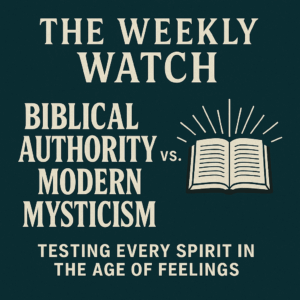⏱️ Estimated Reading Time: 9 min read
The United States has never been more educated than it is now. More people hold high school diplomas, undergraduate degrees, and graduate degrees than at any point in our nation’s history. And yet, research shows a worrying trend—Americans are spending fewer hours reading than ever before.[i] Ed Stetzer has cited a Pew Study that “23 percent of [Americans] didn’t read a single book in [2013],” noting, “that’s three times the number who didn’t read a book in 1978.”[ii] Although we like academic credentials, we do not seem particularly interested in learning from books.
Christians are not exempt from this trend. Pastors and Christian leaders have observed a decline in Bible reading among church members. As a result, congregations are less and less acquainted with their Bibles.
Cherishing the reading of the written Word of God is part of our heritage as Protestant believers. Believers like Martin Luther and William Tyndale sacrificed time, effort, and blood to put the Bible into the hands of the people. The Protestant Reformation was a movement shaped by the reading, preaching, and application of the Bible. In the last two centuries alone, countless translators and missionaries have dedicated their lives to bring God’s Word to people around the globe, and to help them understand its teachings.
But we have even higher reasons to be people of the Book. The Bible itself gives us numerous commands to read, study, meditate upon, pray through, and apply the Scripture (Psalms 19, 119). Change in the Christian life comes as the Scripture, in the hands of the Spirit, brings transformation and renewal to the mind (Romans 12:2). In light of “the fierce wolves” who will enter the church, and leaders who “speak twisted things, to draw away the disciples after them,” Paul commends the Ephesian elders “to God and to the word of his grace, which is able to build you up and to give you the inheritance among all those who are sanctified” (Acts 20:30-32). We need the Bible, and we need to read our Bibles. It is not an overstatement to say that our spiritual lives depend upon it.
So, what are some practical steps that Christian leaders can take to promote Bible reading among those whom they serve? Rather than browbeating or shaming, how can we encourage Christians to read their Bibles regularly, thoughtfully, and enthusiastically? Let’s look at five practical steps that we can take.
First, as leaders, we need to take a good look in the mirror. Are we regularly reading and meditating upon the Bible? Our first response may be, “Of course I am! I deliver Bible lessons and sermons every week, and I study Scripture in my preparations.” We should be doing that, of course, but that is not enough. We should regularly be spending time in Scripture, quite apart from any ministry preparations that we may have. We should come to the Scripture in the same way that any other Christian should come to the Scripture—as a needy sheep who needs to hear the voice of his Shepherd, as one who hungers and needs to feed on the Bread of Life, as one who thirsts and needs to drink from Living Water. One reason that Christ puts us in the church is to provide models or examples to the flock (1st Timothy 4:12). Are we modeling—or will we model—to those whom we serve this basic, but critical, discipline of discipleship?
There are many ways to go about doing this. Twenty-five years ago, a trusted Christian friend put into my hands M’Cheyne’s annual Bible reading plan.[iii] It takes me through the Old Testament once a year, and the New Testament and the Psalms twice a year. It has me read four chapters each day. I can honestly say that I would never have disciplined myself to read Scripture with that kind of regularity. But having a schedule has made all the difference. But if a schedule like M’Cheyne’s doesn’t work for you, that is alright. There are other schedules. There are websites and apps. There are Bibles printed so that you can read them in a year.[iv] The important thing is to pick something and to stick with it. Eventually, it will become a habit, as natural to you as brewing your morning coffee or combing your hair.
And we should encourage one another to do this. Perhaps the leadership of the Church can band together to commit themselves to reading the Bible regularly. They don’t all have to be using the same plan or method. The important thing is that each of them is doing something. As any athlete can tell you, it is much easier to keep a consistent workout regimen when you are training with friends. Camaraderie, accountability, and encouragement—these can make the difference between a runner who starts well but gives up, and a runner who stays the course for the long haul.
Second, as we teach the Bible, we must do so in at least two ways. First, we must be teaching the Bible as it is—a story with a beginning, middle, and finish.[v] The Bible begins with creation, reaches its climax in Christ, and comes to its glorious consummation at Christ’s return. For many Christians, the Bible is a big jumble—Leviticus, Ezra, and Jude all seem to run together. Helping the Church to see how the Bible moves from promise to fulfillment, and from shadow to Christ, will not only give clarity to Christians as they read their Bibles, but it will also encourage them to read whatever part of the Bible they are reading in light of this grand unity. This is something Jesus did for his disciples (Luke 24:25-27, 44-49), and that the Apostles did for the earliest Christians (1st Corinthians 10:1-13; Romans 15:4). Standing on that foundation, we have the privilege of doing the same for God’s people today.
But there is another way to teach the Bible. The Bible is a systematic unity. It teaches truths about God, humanity, and salvation. For centuries (and perhaps even in the New Testament itself), the central truths of Scripture were summarized in creeds and confessions. At the time of the Reformation, pastors and churches began preparing catechisms—question and answer surveys of the system of doctrine found in Scripture. These were invaluable tools for teaching not only adults, but also children. Expositional preaching combined with catechesis helped to produce mature congregations, well-grounded in the Scripture.
Third, in public worship, we should consider reading aloud a chapter or so of Scripture, in addition to whatever passage of Scripture we will be reading for the sermon. The Westminster Divines’ “Directory for the Public Worship of God” encourages the “public reading of the Holy Scriptures” and gives good, practical counsel for doing so in congregational worship.[vi] One benefit, they note, is that it gives the church broad exposure to the whole of Scripture. It also allows the pastor or elder reading the Scripture to make a few, brief comments by way of exposition and application.[vii] Doing this helps to train the congregation to be better readers of Scripture, and parents to teach and to explain the Scripture to their own children.
Fourth, we should not be afraid to encourage people from the pulpit to read their Bibles during the week, privately and with their families. This can be done in the application portions of our sermons and lessons. It might surprise us—but shouldn’t—how often the Bible calls us to read, study, meditate, talk about, and apply the contents of Scripture. Seizing these moments for application in the course of regular Bible teaching in the Church will provide natural avenues to encourage God’s people to be reading Scripture through the week. And, of course, we can reinforce these exhortations and encouragements as we shepherd the flock through regular visitation.
Fifth, we must regularly pray for ourselves and for our people. Bible reading is good, but it is never an end in itself. It is possible to be voracious readers of Scripture and to be far from God. The Pharisees of Jesus’s day were such people—deeply learned, outwardly pious, but inwardly rotten (Matthew 23:27). Jesus challenged the leaders of His day when He told them, “You search the Scriptures because you think that in them you have eternal life; and it is they that bear witness about me, yet you refuse to come to me that you may have life” (John 5:39-40).
The goal of reading the Scripture is to learn of Christ and to come to Him for life. And when we have this goal before us, we have the most powerful motivation to take up the Scripture and to read it. We come to hear—again and again—the voice of the Son, who has set us free; of the Good Shepherd, who has laid down His life for the sheep (John 8:36; 10:11-16). Let’s pray earnestly—for ourselves and for others—for hearts that long more and more to hear and to learn from the Savior. Education and credentials are good things, but they pale in comparison to being with Jesus (Acts 4:13). May the contemporary Church be known not merely as those who love their Bibles, but as those who love their Bibles because they love Jesus.
References:
[i] Caleb Crain, “Why We Don’t Read, Revisited” The New Yorker (June 14, 2018), https://www.newyorker.com/culture/cultural-comment/why-we-dont-read-revisited
[ii] Ed Stetzer, “Dumb and Dumber: How Biblical Illiteracy Is Killing Our Nation,” Charisma, https://www.charismamag.com/life/culture/21076-dumb-and-dumber-how-biblical-illiteracy-is-killing-our-nation
[iii] https://www.mcheyne.info/calendar.pdf.
[iv] See, representatively, the resources listed at https://www.ligonier.org/blog/bible-reading-plans/.
[v] So rightly, Stetzer, “Dumb and Dumber.”
[vi] The whole Directory merits a close reading. For a version that is “formatted, annotated, and lightly modernized,” see http://www.onthewing.org/user/Directory%20for%20the%20Public%20Worship%20-%201645.pdf
[vii] To this end, I have found Matthew Henry’s Commentary on the Whole Bible to be tremendously and consistently helpful, https://www.biblestudytools.com/commentaries/matthew-henry-complete/
Dr. Guy Prentiss Waters is James M. Baird Jr. Professor of New Testament at Reformed Theological Seminary in Jackson, Miss., and a teaching elder in the PCA. He is author of How Jesus Runs the Church.




